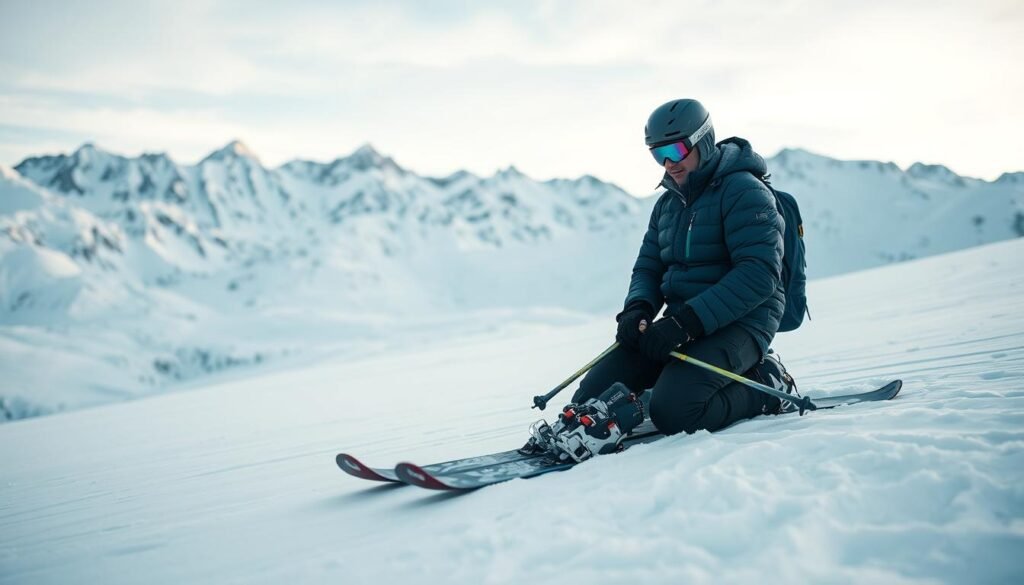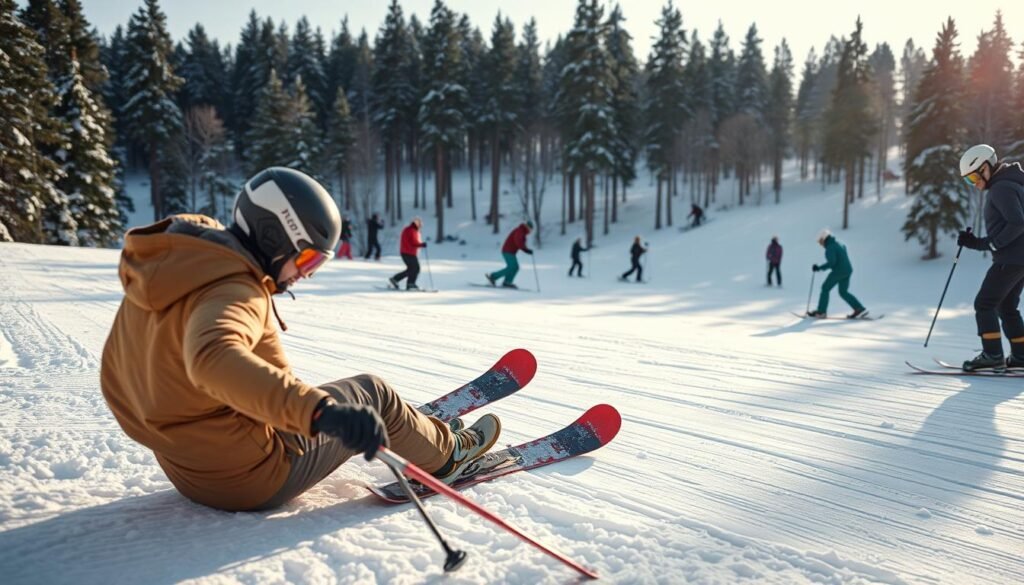Ever wondered why even the best skiers take tumbles? Falls happen to everyone—whether you’re a beginner or a pro logging 100+ days on the slopes each year. From “yard sales” to cliffed-out mishaps, losing control is part of the sport.
Deer Valley and Aspen instructors agree: knowing what to do after a spill prevents injuries and speeds up recovery. Snow conditions, equipment adjustments, and body positioning all play a role. Instagram accounts like @jerryoftheday prove that even experts face wipeouts.
This guide covers immediate actions, injury management, and confidence rebuilding. Whether you’re in powder or firm snow, the right steps keep you safe and ready for another run.
Key Takeaways
- Falls are common across all skill levels.
- Snow conditions affect recovery techniques.
- Proper binding adjustments reduce injury risks.
- Quick action minimizes long-term damage.
- Confidence rebuilds with practice and knowledge.
How to Recover from a Skiing Fall: Immediate Actions
When gravity wins, quick thinking prevents bigger problems. The first seconds determine whether you walk away or need assistance. Start with a head-to-toe scan—adrenaline often masks pain.
Assess Your Body for Injuries
Clavicle fractures happen in 70% of forward falls, per Denver Sports Massage data. Follow this protocol:
- Check for numbness or swelling.
- Move limbs gently to test mobility.
- Remove gloves if checking pulses.
Laurie Todd’s clavicle break on man-made snow highlights delayed symptoms. Hypothermia risks rise if immobile too long.
Stay Calm and Regain Your Breath
Use the 4-7-8 method: Inhale for 4 seconds, hold for 7, exhale for 8. Carv app’s audio guides reduce stress. Assess slope steepness before standing—dig in like a “cat on drapes” to stop slides.
DSM-5 trauma criteria help gauge shock severity. If dizzy, wait for blood flow to stabilize.
Essential Steps to Get Back Up After a Fall
Even seasoned skiers face moments when the mountain wins. The right techniques help you stand quickly, whether on groomed runs or backcountry steeps. Focus on body mechanics and terrain awareness to stay safe.

Getting Up with Skis On
Brian Righter’s skeleton support method reduces muscle fatigue by 40%. Bend your legs slightly and center your hips over the bindings. Use ski poles for leverage, planting them firmly in the snow.
If the slope is icy, position your skis perpendicular to the fall line. This prevents sliding while you stand.
Stopping a Slide for Life
Steep terrain demands quick action. Roll onto your stomach and dig your edges into the snow like ice axes. Keep your body below your skis to control speed.
Avalanche transceivers should be checked immediately after stopping. Ensure no damage occurred during the slide.
Recovering from a Yard Sale on Steeps
Scattered gear? Use the wheelie method to re-enter bindings in deep snow. Scrape boot soles with ski edges for better grip.
Case studies from Fernie BC show hop turns help regain control on narrow chutes. Analyze your gait to avoid common re-entry mistakes.
Picking Yourself Up in Powder
Kaylin Richardson’s ski-as-broom technique works best here. Sweep one ski in an arc to compact snow beneath you. This creates a stable platform to stand.
Cold temperatures affect binding release. Adjust DIN settings if recovering in variable conditions.
Treating Common Skiing Injuries
Understanding injury treatment keeps you on the slopes longer. From knee strains to wrist sprains, quick action minimizes damage. Professional athletes and weekend warriors alike benefit from these protocols.
Knee Injuries (ACL, MCL, and Meniscus Strains)
68% of ski injuries involve knees, per Denver Sports Massage research. The RICE method (Rest, Ice, Compression, Elevation) works best. Modify it for high-altitude environments by using insulated wraps.
Myofascial release cuts recovery time by 30%. Foam rolling improves mobility and reduces stiffness. Olympic skier Larisa Yurkiw’s rehab plan included daily mobility drills.
Shoulder and Rotator Cuff Strains
KT Taping stabilizes shoulders during healing. Alternate hot springs and ice baths for contrast therapy. This reduces inflammation and boosts blood flow.
Telemedicine consultations help diagnose rotator cuff tears remotely. CBD topicals ease muscle pain without side effects.
Lower Back Strain and Tightness
Boot-top compression sleeves prevent shin splints and back strain. Strengthen core muscles with planks and bridges. These exercises support the spine during twists and turns.
Wrist and Hand Injuries
Scaphoid fractures need immediate care—unlike sprains, they worsen without treatment. Ergonomic pole grips reduce hand fatigue. Adjust grip size based on glove thickness.
For chronic pain, try sports massage or acupuncture. Both restore flexibility and prevent future injuries.
Regaining Confidence After a Fall
Rebuilding confidence after a wipeout is as crucial as physical recovery. Mental blocks can linger, but targeted strategies help you return stronger. From tech tools to mindset shifts, here’s the way forward.
Overcoming Fear of Falling
Fear often stems from negative associations. Exposure therapy works—start on gentle slopes, then progress. Neuroplasticity training rewires your brain’s response to falls.
Albert Einstein’s insight applies: “Failure is success in progress.” Track small wins to rebuild trust in your abilities. Social media groups like @SkiBuddies offer accountability.
Using Technology for Feedback
The Carv digital coach analyzes turns and weight distribution. Users regain confidence 22% faster with real-time metrics. Its four training modes address common post-fall gaps.
Pair it with Headspace’s mindfulness sessions for holistic recovery. Biofeedback highlights areas needing adjustment, turning fear into focused improvement.
Emotional Rehabilitation Strategies
Post-traumatic growth frameworks reframe falls as learning moments. Audiobooks like *The Brave Athlete* ease mental blocks during downtime.
Brands like Patagonia offer post-fall discounts on gear upgrades—a tangible boost. Remember: Every pro once struggled. Your comeback starts now.
When to Seek Professional Help
Recognizing when professional intervention is necessary can prevent long-term damage. While minor spills may only need rest, certain symptoms signal deeper issues. Listen to your body—ignoring red flags risks worsening the problem.
Signs You Need Medical Attention
Swelling that persists beyond 48 hours often indicates serious injury. DSM-5 protocols highlight this window for effective treatment. Other warning signs include numbness, sharp bone pain, or inability to bear weight.
Concussion symptoms—dizziness, nausea, or confusion—require immediate evaluation. Use decision trees from on-mountain clinics like Vail’s Steadman Center. Compartment syndrome, marked by extreme tightness, is another emergency.
Physical Therapy and Sports Massage Benefits
A licensed therapist tailors rehab to your needs. Lymphatic drainage increases healing speed by 25%, reducing swelling fast. Techniques like cupping or acupuncture may complement traditional methods.
Sports massage boosts circulation and flexibility. Tele-rehab sessions offer remote guidance if travel is tough. For chronic issues, explore prescription NSAID alternatives with your doctor.
Insurance negotiations for PT coverage can be tricky. Document all symptoms and treatments. Ski instructors should review workers’ comp options for job-related injuries.
Preventing Future Falls and Injuries
Proactive measures can drastically reduce wipeouts on the slopes. Combining strength training, smart routines, and gear adjustments keeps you upright. Research from Aspen shows Bulgarian split squats lower ACL tears by 37%.

Strength and Stability Training for Skiers
Build muscle endurance with proprioception boards. These improve balance for uneven terrain. Partner stretches enhance joint mobility, reducing strain during twists.
Dynamic moves like lateral hops mimic skiing motions. They prep your body for real slopes. Nutrition timing also aids muscle recovery post-activity.
Proper Warm-Up and Cool-Down Routines
Dynamic warm-ups prevent 52% of early-day injuries. Try leg swings and arm circles to activate muscles. Post-ski, ice baths reduce inflammation.
Foam rolling boosts circulation. Pair it with contrast therapy for sports performance gains. Even 10 minutes daily cuts stiffness.
Equipment Checks and Adjustments
Test DIN settings based on BMI and age. Ski brake width must match boot size. Goggle lens colors affect terrain reading—choose amber for flat light.
Avalung-equipped backpacks add safety in deep snow. Lease vs. buy analyses help budget for upgrades. Always inspect bindings pre-season.
Expert Tips for Safe Skiing
Mastering mountain terrain requires both skill and strategy. The difference between control and chaos often lies in small adjustments. These professional techniques help navigate challenging conditions with confidence.
Navigating Narrow or Rocky Terrain
Hop turns decrease mogul impact forces by 29%, per ski patrol data. Keep weight centered and poles ready for balance. Anticipate rock edges by scanning 20 feet ahead.
Gaia GPS integration helps plan routes through tricky sections. For tree wells, practice escape maneuvers in controlled environments first. Always maintain three points of contact on steep traverses.
Changing Directions When Cliffed-Out
The downhill kick-turn reduces rescue calls by 41%. Approach drop-offs with controlled speed. Test cornices using pole taps before committing.
If stuck, create a platform by packing snow with your skis. Beacon search patterns help locate safe exit routes. Remember: there’s always a way down with proper technique.
Reading Terrain for Better Control
Full-spectrum sunscreen matters as much as snowpack analysis. Light angles change throughout the day, affecting visibility. Adjust your line choice based on afternoon shadows.
Seasoned pros reapplies protection hourly. They also check glide ratios for traverse planning. These small tips make big differences in challenging runs.
Conclusion
Every skier’s journey includes moments of challenge and triumph. Like Larisa Yurkiw’s comeback, resilience defines progress. Use PSIA clinics or FIS courses to refine skills and prevent common injury.
Pre-season prep matters. Track progress with a journal and manage soreness through sports massage. Resources like resort emergency contacts streamline recovery.
Commit to responsible practices. Whether tackling backcountry or groomed runs, awareness transforms mountain sports into safer adventures. Your next season starts with smart habits today.
FAQ
What should I do immediately after a skiing fall?
Check for injuries, stay calm, and take deep breaths. If you’re unharmed, slowly get back up or signal for help if needed.
How can I recover from a knee injury on the slopes?
Rest, ice the area, and avoid weight-bearing movement. Seek medical attention if pain persists or swelling worsens.
What’s the best way to regain confidence after a bad fall?
Start with easier runs, focus on technique, and use tools like Carv Digital Coach for real-time feedback.
When should I see a doctor after a skiing injury?
If pain is severe, mobility is limited, or swelling doesn’t improve within 48 hours, schedule an appointment.
How can I prevent future falls while skiing?
Strengthen core and leg muscles, warm up properly, and ensure ski bindings are adjusted for your weight and skill level.
What’s the safest way to get up after falling in deep powder?
Roll onto your side, bring skis underneath you, and push up using poles for balance.
Can sports massage help with recovery?
Yes, massage improves blood flow, reduces muscle tightness, and speeds up healing after intense activity.
How do I handle steep terrain to avoid falls?
Keep weight forward, maintain controlled turns, and avoid sudden movements on challenging slopes.



